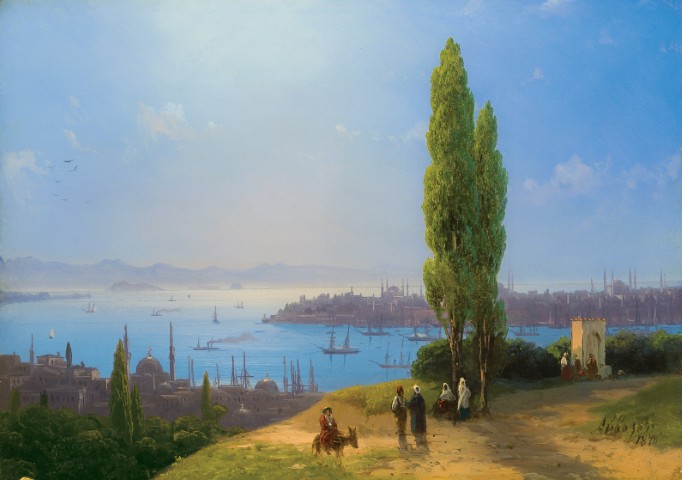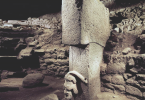“Cypress” is the symbol of man’s existence from birth to death and of unity, which is becoming one, in Turkish traditions and social beliefs.
Contributor: RECEP KANKAL
Many symbolic elements have been part of certain belief systems in every period of humanity. In Turkish tradition, in relation to Sky God and earth-water belief system, it is observed that sky, water, fire, tree and plants were deemed sacred or the deep meaning of a certain holy figure was attributed to these elements. Beliefs related to trees have been survived in Turkish communities. As part of this belief system, “Cypress Tree” motif is one of the common images both in Turkish communities of ancient periods and arts of Seljuk and Ottoman Empires.
A Symbol in Turkish Tradition: Cypress Tree
“Cypress” is the symbol of man’s existence from birth to death and of unity, which is becoming one, in Turkish traditions and social beliefs. Cypress, a strong and durable evergreen tree that survives harsh seasonal conditions, represents life itself. It is also believed to represent truth due to its form: its upright trunk reaches up to the sky. There is another belief that cypress tree brings good luck and protection. In ancient Turkish culture, cypress tree is described as the tree of life which symbolizes abundance and plenitude in relation to this belief. The most important reason behind this is it having roots underground, a trunk over the ground and leaves reaching up to the sky. This trinity, this belief is evocative of birth, life and the desire to reach the heavens. Cypress being evergreen despite seasonal conditions symbolizes immortality. Cypress with a form resembling that of minaret is the tree of life and the birds on its branches symbolize living souls that is people. Cypress is attributed a mystical meaning for it requires sunlight and therefore never stops growing taller.
Essential Decoration in Ottoman Graveyards: Cypress Tree
Cypress tree is identified with tree of life, and the tradition of planting it in graveyards and sacred grounds, reveals that people believed cypress to possess supernatural powers, cypress wood’s oils with strong odours mask even the smell of the dead and make it possible to safely cross to the next world. Egyptians utilised cypress wood to preserve mummies and prevent them from spoiling, which is probably based on this belief.
In Ottoman tombstones, and particularly in the foot stones of graves of women, tree of life motif was common as well as cypress motif. As cypress moves in the wind, it is believed that the rustle of its branches evokes a praying dervish and the dhikr “Hû!” meaning “That God”. As the sound of wind introduces a spiritual atmosphere, it is said that the reason behind planting cypress to cemeteries is to spite the “Hû!” sounds in harmony with the wind. The source of this belief is the following verse in the Holy Koran: “All living and non-living beings on earth, utters the name of God in their own languages.” Due to these symbolic meanings, cypress figure has been engraved on tombstones and cypress trees have been planted in graveyards which is a tradition still survived.
Maurice M. Cerasi relays that, contrary to Jewish cemeteries called “maşatlık”, trees are planted in Muslim graveyards outside cities which are at the same time recreational areas and esplanades . Those located in cities are monumental structures which complement the architecture and travellers depicted people who sang, ate, and promenaded in the graveyards.
“Curtain to Afterlife, Graceful Cypress”
Due to the meaning attributed to cypress, it has also been an essential symbol in literature. As cypress is used with reference to the height of the loved one, the expressions “serv-i hıraman” meaning swaying lover and “kadd-ı elif” or “serv-kad” meaning tall lover can be seen in couplets and poems. Necip Fazıl emphasizes in his poem My Dear Istanbul that the height of cypress curtains the afterlife: “History has eyes, holes on the walls; Cypress, graceful cypress, curtain to afterlife.” Similarly, in his first published poem In Cypress Groves Nazım Hikmet deals both with melancholy and emotions in the verse “Do they still cry on the cypress trees?”. Again in Death of Rinds, Yahya Kemal points out the lyrical existence of cypress trees in the verse “And in his grave under cool cypresses/ A rose blossoms each morning, a nightingale sings each night.”
Cypress as a Mystical Meaning
Next to its symbolic quality in literature, there is reference to the form of cypress resembling the first letter of Arabic alphabet Elif. Elif is also the first letter of the word “Allah” and symbolizes unity, and therefore it is interpreted through different perspectives and used as a religious term. The conical form of Kadiri cones, a mosaic of Anatolian beliefs, also possesses this depth in meaning. The lower branches of cypress, symbol of cypress, is evocative of a person praying with open hands. Its upper branches face the ground just like a destitute dervish who has realised his helplessness before the Creator. In addition, the upright and shapely form of the tree is the symbol of integrity and honesty and its tenacity against wind is the symbol of patience. This state is likened to abandoning the worldly pleasures in Sufism.
“Like a Chess Decoration”
Most travellers who visited Istanbul spoke of the cypress trees in Istanbul and cypress groves in graveyards in their travel notes. Like Edmondo de Amicis who depicted Istanbul in 1870s, Elizabeth Lady Craven who visited Turkey in 1786, addressed the natural beauty created by cypress trees. Similarly, in depicting the garden of the Shipyard near Hasköy, Evliya Çelebi likened 12 thousand rowed cypress trees to a chess decoration: “It resembles a garden of Eden with the odour of trees and various decorative plants and there are thousands of cypress trees in these vineyards looking up to the skies which fascinate and amaze people.” Evliya relays that Mehmed the Conqueror planted “seven cypress trees with his blessed hands” after the conquest of Istanbul which are all tall, shapely and green, and Aksemseddin also planted one with his blessed hands. In depicting the yard of Fatih Mosque he says, “There are green cypress trees as high as minarets reaching to the skies, each resembling a green angel”. Again Mrs. Max Müller who visited Istanbul in 1893, points out to the rumours that the fragrance of cypress trees removes all negative effects during cemetery visits.
Cypress Tree in Motifs
Cypress motifs are not exclusively observed on historical buildings, in cemeteries or religious grounds. Artists made sure to place a cypress in a corner of their Istanbul or Anatolia paintings with delicate touches of their brushes. The best example to that is an Istanbul painting by Ivan Aiwasowski; with a cypress tree he painted in the centre of the painting, another natural beauty came to the fore besides Istanbul. Cypress trees can be observed alongside flower motifs in tiling that is a precious craft in Ottoman arts. Cypress pattern can be observed even today on the tiles, particularly in altars of historical mosques, water-tanks, on the second crown gate in historical Ishakpaşa Palace and in harem chambers of Topkapı Palace. Cypress trees as figures are decorative elements also in ceramics. Cypress trees are visually featured in works of writing. Particularly in hand-written manuscripts, one or more cypress trees are drawn in depicting events or in nature drawings in miniatures. Cypress motif is also featured alongside flower decorations both in calligraphy and Ottoman edicts. The upward triangular form, shaped by symbols around the letters of Sultans’ names in sultans’ signatures in edicts, symbolizes the trunk of cypress growing taller. As well as tree of life figure common in Turkish textile arts, cypress figure can be seen on prayer rugs, rugs, stained-glasses, carpet decorations and on historical fountains. Next to cultural and artistic dimension of cypress, archive documents show that the roots of cypress were burnt in various non-Muslim neighbourhoods as a protection against cholera. A similar practice is known to popular in Egypt in ancient times.
Cypress tree is preferred because scientific studies assert that it prevents emission of ammonium, it has a beautiful fragrance due to the resin it contains, an aesthetic appearance, and is a perennial evergreen tree. Additionally in Turkish tradition, cypress tree has become a popular visual element in Turkish art and beliefs with these attributed meanings. With these aspects, cypress tree on tombstones and in Turkish visual arts, is considered a symbol reminding people of death in the least bothersome fashion.









Leave a Comment